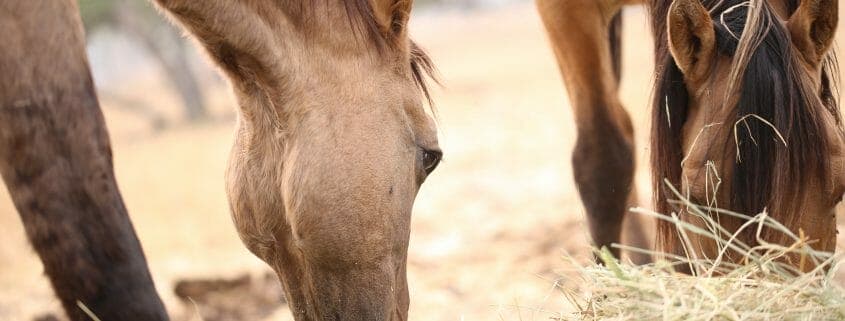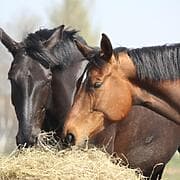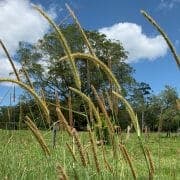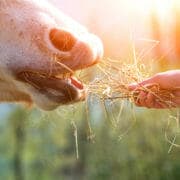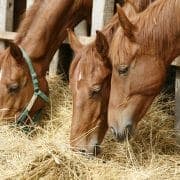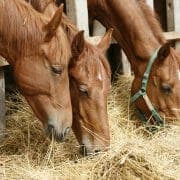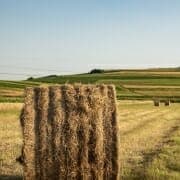Straw as an Alternative Forage for Easy Keepers
Straw is gaining favouritism among nutritionists and horse owners as part of diets for easy keepers. It allows energy intake of the diet to be reduced without drastic restriction in a horse’s daily feed intake.
This strategy is thought to improve the welfare of easy keepers and reduce the risk of colic and gastric ulceration, all common issues seen with feed restriction.
A recent study that substituted 50% of the grass haylage component of the diet with straw for horses, further supports the use of straw in easy keeper diets.
The main findings in the study (Jansson et al 2021) were that the 50% straw diet had:
- No effect on squamous or glandular gastric ulcers scores
- Longer feed intake times and lower energy intakes
- Lower Insulin concentrations (a positive for those prone to laminitis)
- A trend for higher serotonin levels (a key hormone that stabilises mood; inhibits aggression, fear and stress; supports intestinal motility; plays a role in fat tissue metabolism)
- Gut sounds that reflected normal motility patterns and no changes in manure moisture content– indicating no major adverse effects on gut function.
Why Should You Consider Including Straw for Your Easy Keeper?
It is now widely accepted that horses should be eating a minimum of 1.5% of their bodyweight in forage per day (dry matter basis). This supports natural behaviour and minimises the risk of health complications such as gastric ulcers and colic.
However, for some easy keepers, this amount of forage alone can exceed energy requirements. Therefore, replacing some higher energy forage in the diet with low energy straw can allow owners of easy keepers to reduce the energy content of the diet without restricting intake below 1.5% of bodyweight.
More bulk. Less energy! Happier horses!!
Isn’t There a Risk of Gastric Ulcers on Straw Diets?
A previous study published in 2009 reported the incidence of gastric ulcers (both glandular and squamous) was increased in horses fed straw as their only roughage source. The authors (many of which are the same authors on the above-mentioned paper) suggested that mechanical damage, changes in the gastric contents, specifically the fibre ‘mat’ that forms in the stomach, and reduced buffering capacity due to low calcium and protein content of straw could have been the cause.
However, in the present study the severity and incidence of gastric ulcers decreased over the study period (2 x 21 days). This suggests that including up to 50% of the forage in diets as straw does not increase the risk of gastric ulceration.
And in fact the slower intake of straw is likely to be a good strategy for ensuring horses don’t go longer than 4 hours without feed. Which should then act to reduce the risk of ulcers.
Decreased Feed Intake, No Time Without Forage
The 50% straw diet offered in 2021 study contained the same amount of energy as the haylage only diet. This meant that horses on the straw diet were receiving more forage (based on dry matter) than the haylage diet.
However, the researchers found that the horses on the straw diet actually had leftovers which resulted in them consuming less energy each day (10.7MJ per 100kg bodyweight) compared with the haylage group (12.4MJ per 100kg bodyweight).
This suggests that because horses are ‘fuller’ or more satisfied on the straw diet, they are likely to eat less forage which may decrease energy intake without the need for intake restriction.
Longer Periods Spent Eating
Another benefit of the 50% straw diet was that horses spent more time eating each day compared with the haylage only diet. The authors calculated that the horses on the straw diet spent 11.2 hours per 24 hours eating whereas the control diet horses spent 6.2 hour per 24 hours eating – an 80% difference!
The most likely explanation is differences in palatability or some physiological response as the NDF (measure of the cell wall components such as hemicellulose, cellulose and lignin) content of the two diets was very similar – NDF content is correlated to intake.
The authors noted that interestingly, the horses on the straw diet spent more time pausing their feed intake whereas the haylage diet was consumed almost at all at once.
Lower Insulin Response
Many easy keepers are at increased risk of laminitis. It is therefore in our best interest to feed a low sugar and starch diet which limits glucose and insulin responses.
In the present study, the insulin response was lower on the 50% straw diet than the haylage only diet. The total water-soluble carbohydrate (WSC) intake was significantly lower for the straw diet (60g vs. 75g per 100kg bodyweight) so this was not unexpected but does highlight another possible advantage of including straw in diets.
Be mindful that this cannot necessarily be generalised for all straw and analysis is recommended to determine the actual starch and WSC content of any straw you might consider using.
Also interesting to note that the grass forages used in this study were by no means high in WSC, being 7.7% and 4.9%, as compared with the straw being 0.8%.
Higher Serotonin Levels in Horses on the 50% Straw Diet
This is super interesting and the authors offered the explanation that chewing more and being more satisfied from a hunger perspective is potentially increasing serotonin levels and may be the reason why horses are eating less and taking more pauses between eating when offered the 50% straw diet.
It is well known in humans that spending longer chewing meals reduces hunger levels, with chewing stimulating serotonin.
Does Feeding Straw Increase the Risk of Impaction Colic?
The present study showed no difference in gut sounds between the haylage only diet and the diet with 50% inclusion of straw over the 21-day study periods. Nor did the moisture content of the manure vary between the two groups.
A lack of fecal moisture (or in other words, the presence of dry manure) may indicate increased risk of impaction colic. The authors noted that certain individuals and even some breeds are more prone to impactions and owners should be cautious.
All changes in forages should be made gradually over several weeks to minimise the risk of colic providing a chance for fibre digesting bacteria to adapt.
No More HANGRY Horses on a Straw Diet?!
Using straw in diets can add another string to our bow for managing the weight and seemingly insatiable appetite of easy keepers.
The results of this study suggest that inclusion of up to 50% of the forage ration as straw does not cause gastric ulcers and may in fact improve the welfare of easy keepers by reducing energy intake on ad lib hay and prolonging the time they spend eating.
Straw in effect lets us feed more bulk, while providing less energy. And keeps our horses fuller, happier, chewing for longer and less stressed!
You might also be interested in our article ‘Using Straw to Achieve Weight Loss in Horses’.
Full article https://www.mdpi.com/2076-2615/11/8/2197
Jansson, A., Harris, P., Davey, S.L., Luthersson, N., Ragnarsson, S.and Ringmark, S. Straw as an Alternative to Grass Forage in Horses—Effects on Post-Prandial Metabolic Profile, Energy Intake, Behaviour and Gastric Ulceration. Animals, 2021, Issue 11, Volume 8, Pages 2197-2211.
Do you have a question or comment? Do you need help with feeding?
We would love to welcome you to our FeedXL Horse Nutrition Facebook Group. Ask questions and have them answered by PhD and Masters qualified equine nutritionists and spend time with like-minded horse owners. It’s free!
Click here to join the FeedXL Horse Nutrition Facebook Group

